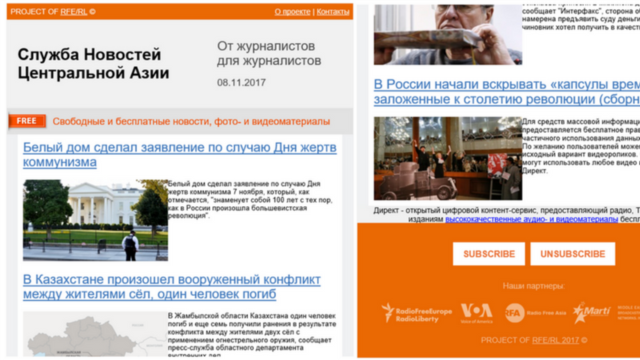RFE/RL Central Asia Newswire Delivers The News From Journalists For Journalists
RFE/RL’s Central Asia Newswire faced broad skepticism when it was launched in August 2015, as several countries in the region rank among the most restrictive media environments in the world.

(PRAGUE—November 14, 2017) RFE/RL’s Central Asia Newswire faced broad skepticism when it was launched in August 2015, as several countries in the region rank among the most restrictive media environments in the world. Two years on, however, the platform has achieved resounding results, proving that, despite formidable challenges, there is significant demand within these societies for accurate information and reliable news.
The Newswire provides professionally reported text, photo, video, and audio content, free of charge, in four local languages, to any media outlet in Kazakhstan, Kyrgyzstan, Tajikistan, and Uzbekistan that wishes to receive it. It currently boasts 1,200 subscribers, and its content is regularly published by 270 media outlets. It averages 1,100 content citations weekly, and its stories are republished or re-posted on average over 5,500 times each month, including by nationwide broadcasters with audiences in the millions.
Central Asia Newswire Director Salimjon Aioubov, the project’s mastermind, has a simple explanation for its success. “We are all journalists, and there is solidarity,” he says. “We know it is hard to harvest good stories and videos, and with RFE/RL’s resources, we can help.”
The Newswire draws on a network of 10 freelancers based in Bishkek, Almaty, Astana, Tashkent, and Dushanbe, who package stories produced by RFE/RL’s language services, maintain relations with media executives, monitor usage, and seek new partners. Content is distributed to subscribers through a daily e-mailed newsletter, but can also be taken directly from the Newswire’s website and, in some cases, social networks.
“What is important is the message, not the messenger.”
The Newswire allows outlets to use its content without attribution, since carrying RFE/RL content can be risky in some of the region’s markets. This makes it difficult to monitor usage accurately, but “What is important is the message, not the messenger,” Aioubov says.
The demand for the Newswire reflects longstanding challenges confronting media in the region, including the modest ranks of professionally trained journalists, the limited funding available to independent outlets, the difficulty of sourcing and producing balanced news, and disincentives to publishing reporting at odds with state-controlled media. (Current Freedom House rankings for media freedom in Kazakhstan, Kyrgyzstan, Tajikistan, and Uzbekistan, out of 199 countries and territories assessed for the 2017 “Freedom of the Press” survey and with 1 being the best, are 179, 148, 186, and 197, respectively.) These factors have left many outlets wanting for credible reporting that provides an alternative take on the headlines, or stories that aren’t otherwise covered in the local press.
More recently, sanctions against Russia have dried up a significant source of external funding for some local outlets. At the same time, Moscow’s annexation of Crimea has eroded the reputation of Russian media in the region, creating new demand for independent news. Newswire content also appeals to editors seeking to balance the deluge of information in their countries from Iran, Saudi Arabia, and China.

Aioubov, who is a former senior broadcaster with RFE/RL’s Tajik Service, says that the Newswire has wrought discernible changes in the region’s media landscape. His colleagues on the ground, he says, report a noticeable boost in the volume of news published relating to neighboring countries, with the Newswire filling what was a yawning gap. Whereas Kazakh media, for example, would normally publish two or three stories weekly on Tajikistan, such stories now number ten or more.
In addition, he believes the availability of an alternative to Russian news has broadened the perspective and expertise of local political analysts, and made local journalists smarter. “You can spend millions of dollars to make fake news and propaganda, but one small objective piece of news will destroy it all,” he says.
Looking ahead, Aioubov is now piloting a weekly press review highlighting Western news that is subscribed to by over 20 news outlets in the region, including major news agencies and channels in Kyrgyzstan and Tajikistan.
The Newswire has also made a tentative entry into Uzbekistan, recently attracting 24 new subscribers who use an average of 170 stories weekly despite ruthless state control over all media. Several Uzbek outlets also subscribe to the Western press review.
Aioubov sees Turkmenistan as the next, if not distant, frontier. Turkmen authorities have targeted RFE/RL’s local reporting network over the last two years, imprisoning two journalists and subjecting others to intimidation and physical attack because of their journalism.
For now, he says, looking at the region as a whole, “offering our resources freely is good enough.”